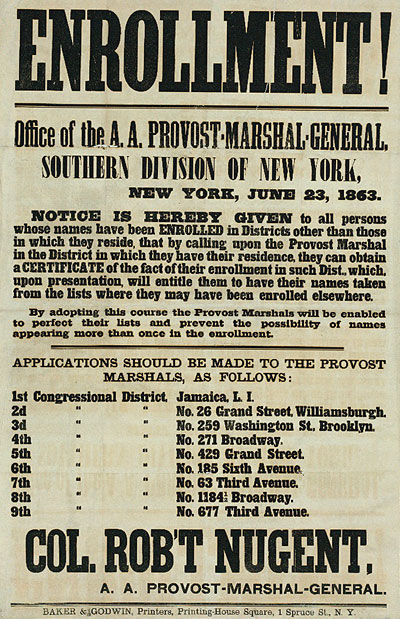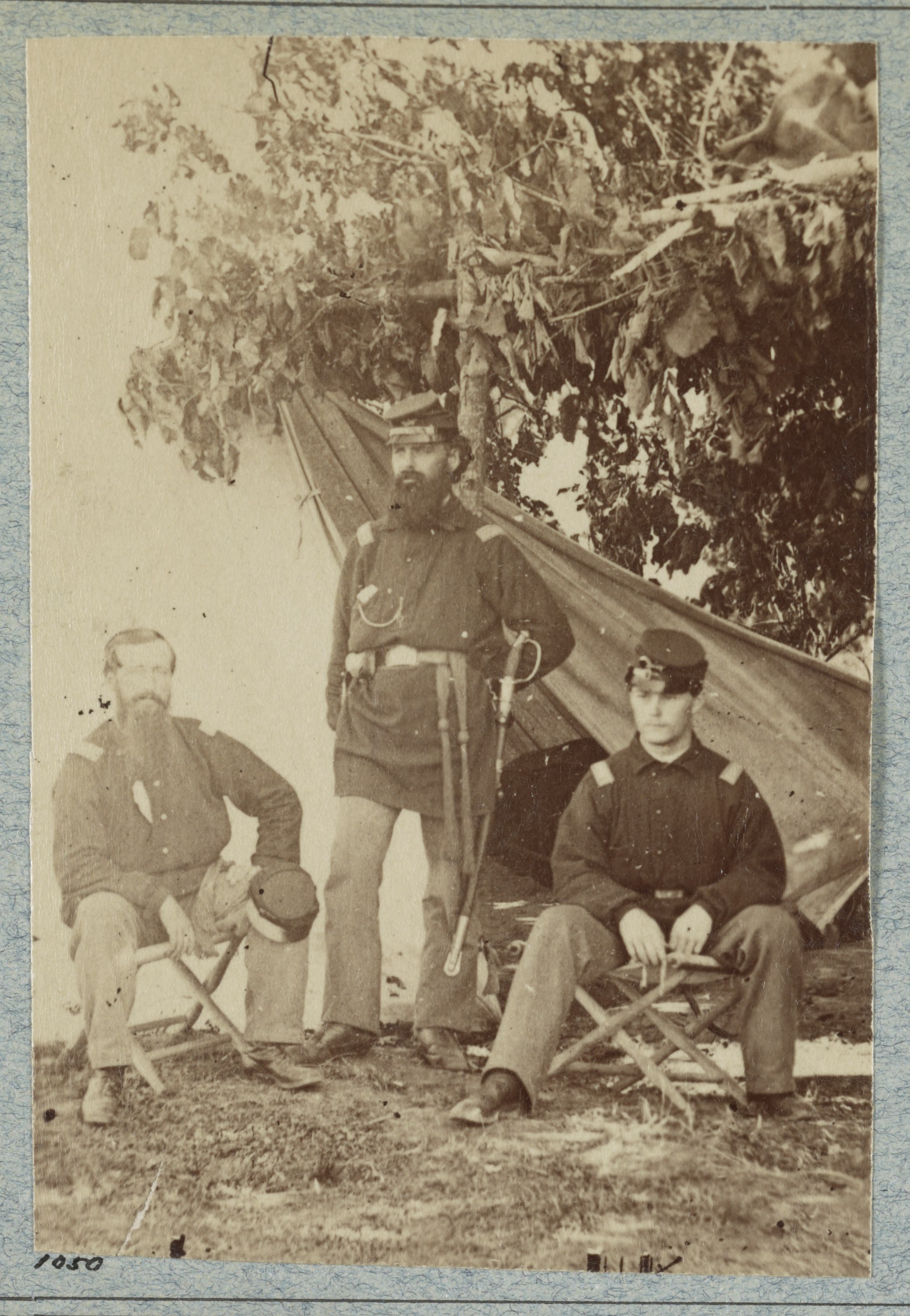|
36th New York Infantry
The 36th New York Infantry Regiment was a New York Civil War regiment. It was a unique fighting force, including both Irishmen and New York Britons, having absorbed the New York British Volunteers while organizing. A colorful group known for its antics and in-fighting, it nevertheless made important contributions to the Union cause at such battles as Seven Pines, Malvern Hill, Fredericksburg, and Chancellorsville. Many of its members were also present during the New York Draft Riots. The unit served from 1861 to 1863. It served closely with the 7th and 10th Massachusetts regiments, along with the 2nd Rhode Island. It was first blooded at the battle of Seven Pines and later participated in the Union victory at Malvern Hill. It was part of a detachment guarding the bridges at Fredericksburg and did not see combat there. In the battle of Chancellorsville, it participated in the capture of Marye's Heights. Before the Gettysburg battle, the two-year enlistment period of its m ... [...More Info...] [...Related Items...] OR: [Wikipedia] [Google] [Baidu] |
35th New York Infantry Regiment
The 35th New York Infantry Regiment, the " Jefferson County Regiment", was an infantry regiment of the Union Army during the American Civil War. Service This regiment was accepted by the State May 25, 1861; organized at Elmira, and there mustered in the service of the United States for two years June 11, 1861. On June 5, 1863 the regiment was mustered out and the men of the regiment were transferred to the 80th New York Volunteer Infantry Regiment. The regiment left the State July 9, 1861; served at and near Washington, D. C., from July, 1861; in Porter's Brigade, Army of Northeastern Virginia, from July, 1861; in Hunter's Brigade, Division of Potomac, from August, 1861; in Wadsworth's Brigade, Irvin McDowell's Division, Army of the Potomac, from October, 1861; in 2d, Patrick's, Brigade, 3d, King's, Division, 1st Corps, Army of the Potomac, from March, 1862; in 2d Brigade, King's Division, Department of Rappahannock, from May, 1862; in 3d Brigade, 1st Division, 3d Corps, Arm ... [...More Info...] [...Related Items...] OR: [Wikipedia] [Google] [Baidu] |
37th New York Infantry Regiment
The 37th New York Infantry Regiment or the Irish Rifles was formed accepted by the State on May 25, 1861, and organized in New York City. The regiment mustered in the service of the United States on June 6 and 7, 1861 for two years of service to June 22, 1863. The 75th New York Militia formed the nucleus of the regiment. Several companies were recruited: H at Allegany, I at Ellicottsville, K at Pulaski, and all others at New York City. Men from the 101st New York Volunteer Infantry The 101st New York Infantry Regiment ( "Union Brigade" and "2nd Onondaga County Regiment") was an infantry regiment in the Union Army during the American Civil War. Service The 101st New York Infantry was organized at Buffalo, New York, and mus ... joined this regiment by transfer on December 24, 1862. An on May 25, 1863, men who had served were consolidated into two companies and these were transferred to the 40th Infantry as Companies I and K. Service The 37th New York had its roots in the 75t ... [...More Info...] [...Related Items...] OR: [Wikipedia] [Google] [Baidu] |
American Civil War
The American Civil War (April 12, 1861 – May 26, 1865; also known by other names) was a civil war in the United States. It was fought between the Union ("the North") and the Confederacy ("the South"), the latter formed by states that had seceded. The central cause of the war was the dispute over whether slavery would be permitted to expand into the western territories, leading to more slave states, or be prevented from doing so, which was widely believed would place slavery on a course of ultimate extinction. Decades of political controversy over slavery were brought to a head by the victory in the 1860 U.S. presidential election of Abraham Lincoln, who opposed slavery's expansion into the west. An initial seven southern slave states responded to Lincoln's victory by seceding from the United States and, in 1861, forming the Confederacy. The Confederacy seized U.S. forts and other federal assets within their borders. Led by Confederate President Jefferson Davis, ... [...More Info...] [...Related Items...] OR: [Wikipedia] [Google] [Baidu] |
New York British Volunteers
The New York British Volunteers was a short-lived regiment in the Union Army during the American Civil War. The unit began recruiting in New York City shortly after the outbreak of the war, and managed to draw several hundred recruits. The regiment was staffed by former members of the British Army, many of whom were veterans of the Crimean War. In a hurry to field as many units as possible, the State of New York transferred the men of the New York British Volunteers to another understrength regiment, the Washington Volunteers. This new formation was designated the 36th New York Infantry. A number of the former officers of New York British Volunteers subsequently resigned, while a number of the rank and file are reported to have deserted. See also *List of New York Civil War units *New York Volunteers External links 36th New York Volunteer Infantry a site designed and researched by descendants of soldiers serving in this regiment, contains an unofficial history British Britis ... [...More Info...] [...Related Items...] OR: [Wikipedia] [Google] [Baidu] |
Battle Of Seven Pines
The Battle of Seven Pines, also known as the Battle of Fair Oaks or Fair Oaks Station, took place on May 31 and June 1, 1862, in Henrico County, Virginia, nearby Sandston, as part of the Peninsula Campaign of the American Civil War. It was the culmination of an offensive up the Virginia Peninsula by Union Maj. Gen. George B. McClellan, in which the Army of the Potomac reached the outskirts of Richmond. On May 31, Confederate General Joseph E. Johnston attempted to overwhelm two Federal corps that appeared isolated south of the Chickahominy River. The Confederate assaults, although not well coordinated, succeeded in driving back the IV Corps and inflicting heavy casualties. Reinforcements arrived, and both sides fed more and more troops into the action. Supported by the III Corps and Maj. Gen. John Sedgwick's division of Maj. Gen. Edwin V. Sumner's II Corps (which crossed the rain-swollen river on Grapevine Bridge), the Federal position was finally stabilized. Gen. Johnsto ... [...More Info...] [...Related Items...] OR: [Wikipedia] [Google] [Baidu] |
Battle Of Malvern Hill
The Battle of Malvern Hill, also known as the Battle of Poindexter's Farm, was fought on July 1, 1862, between the Confederate Army of Northern Virginia, led by Gen. Robert E. Lee, and the Union Army of the Potomac under Maj. Gen. George B. McClellan. It was the final battle of the Seven Days Battles during the American Civil War, taking place on a elevation of land known as Malvern Hill, near the Confederate capital of Richmond, Virginia and just one mile (1.6 km) from the James River. Including inactive reserves, more than fifty thousand soldiers from each side took part, using more than two hundred pieces of artillery and three warships. The Seven Days Battles were the climax of the Peninsula Campaign, during which McClellan's Army of the Potomac sailed around the Confederate lines, landed at the tip of the Virginia Peninsula, southeast of Richmond, and struck inland towards the Confederate capital. Confederate general Joseph E. Johnston fended off McClellan's repeat ... [...More Info...] [...Related Items...] OR: [Wikipedia] [Google] [Baidu] |
Battle Of Fredericksburg
The Battle of Fredericksburg was fought December 11–15, 1862, in and around Fredericksburg, Virginia, in the Eastern Theater of the American Civil War. The combat, between the Union Army of the Potomac commanded by Maj. Gen. Ambrose Burnside and the Confederate Army of Northern Virginia under Gen. Robert E. Lee, included futile frontal attacks by the Union army on December 13 against entrenched Confederate defenders along the Sunken Wall on the heights behind the city. It is remembered as one of the most one-sided battles of the war, with Union casualties more than twice as heavy as those suffered by the Confederates. A visitor to the battlefield described the battle as a "butchery" to U.S. President Abraham Lincoln. Burnside's plan was to cross the Rappahannock River at Fredericksburg in mid-November and race to the Confederate capital of Richmond before Lee's army could stop him. Bureaucratic delays prevented Burnside from receiving the necessary pontoon bridges in time ... [...More Info...] [...Related Items...] OR: [Wikipedia] [Google] [Baidu] |
Battle Of Chancellorsville
The Battle of Chancellorsville, April 30 – May 6, 1863, was a major battle of the American Civil War (1861–1865), and the principal engagement of the Chancellorsville campaign. Chancellorsville is known as Lee's "perfect battle" because his risky decision to divide his army in the presence of a much larger enemy force resulted in a significant Confederate victory. The victory, a product of Lee's audacity and Hooker's timid decision-making, was tempered by heavy casualties, including Lt. Gen. Thomas J. "Stonewall" Jackson. Jackson was hit by friendly fire, requiring his left arm to be amputated. He died of pneumonia eight days later, a loss that Lee likened to losing his right arm. The two armies faced off against each other at Fredericksburg during the winter of 1862–1863. The Chancellorsville campaign began when Hooker secretly moved the bulk of his army up the left bank of the Rappahannock River, then crossed it on the morning of April 27, 1863. Union cavalry under ... [...More Info...] [...Related Items...] OR: [Wikipedia] [Google] [Baidu] |
New York Draft Riots
The New York City draft riots (July 13–16, 1863), sometimes referred to as the Manhattan draft riots and known at the time as Draft Week, were violent disturbances in Lower Manhattan, widely regarded as the culmination of white working-class discontent with new laws passed by Congress that year to draft men to fight in the ongoing American Civil War. The riots remain the largest civil and most racially charged urban disturbance in American history. (updated ed. 2014, ). According to Toby Joyce, the riot represented a "civil war" inside the Irish Catholic community, in that "mostly Irish American rioters confronted police, hilesoldiers, and pro-war politicians ... were also to a considerable extent from the local Irish immigrant community." President Abraham Lincoln diverted several regiments of militia and volunteer troops after the Battle of Gettysburg to control the city. The rioters were overwhelmingly Irish working-class men who did not want to fight in the Civi ... [...More Info...] [...Related Items...] OR: [Wikipedia] [Google] [Baidu] |
7th Regiment Massachusetts Volunteer Infantry
The 7th Regiment Massachusetts Volunteer Infantry was an infantry regiment in the Union (American Civil War), Union army during the American Civil War. It was formed on June 15, 1861, in Taunton, Massachusetts, Taunton. Its original commander was Colonel (United States), Colonel Darius N. Couch who would eventually be promoted to command the II Corps (Union Army), II Corps of the Army of the Potomac and, after that, the Department of the Susquehanna. Organization and early duty The 7th Massachusetts consisted almost entirely of men from Bristol County, Massachusetts. The regiment was trained at Camp Old Colony in Taunton, Massachusetts. On June 15, 1861, its members were mustered into service."Stevens" On July 11, the 7th Massachusetts left for Washington, D.C. where it remained encamped until the spring of 1862. For most of that period, the regiment was stationed in Brightwood (Washington, D.C.), Brightwood, now a neighborhood of Washington but, at the time, outside of the ur ... [...More Info...] [...Related Items...] OR: [Wikipedia] [Google] [Baidu] |
10th Regiment Massachusetts Volunteer Infantry
The 10th Massachusetts Infantry Regiment was a regiment of infantry in the Union Army during the American Civil War. Organized at Hampden Park in Springfield, Massachusetts in the early summer of 1861 and consisting mostly of men from western Massachusetts, the regiment was mustered in on June 21, 1861. It was originally led by Colonel Henry Shaw Briggs, an attorney and prominent citizen of Pittsfield, Massachusetts.Bowen, 196 See also * Massachusetts in the Civil War * List of Massachusetts Civil War units Units raised in Massachusetts during the American Civil War consisted of 62 regiments of infantry, six regiments of cavalry, 16 batteries of light artillery, four regiments of heavy artillery, two companies of sharpshooters, a handful of unattach ... Notes References * * External links10th Mass Volunteer Infantry (Reenactor Group) {{American Civil War , expanded=CTCBS Units and formations of the Union Army from Massachusetts 1861 establishments in Massachusetts M ... [...More Info...] [...Related Items...] OR: [Wikipedia] [Google] [Baidu] |
2nd Rhode Island Infantry
The 2nd Rhode Island Infantry Regiment was an infantry regiment composed of volunteers from the state of Rhode Island that served with the Union Army in the American Civil War. They, along with the 1st Rhode Island, wore a very simple uniform. The uniform composed of a dark blue jacket like shirt, tannish grey pants, and a dark blue chasseur kepi. The 2nd Rhode Island also wore havelocks in the beginning of the war, but after finding them useless they discarded them. Overview The 2nd Rhode Island Infantry Regiment was organized in June 1861 in Providence. The regiment was initially assigned to the IV Corps of the Army of Northeastern Virginia (later became the Army of the Potomac) and saw its first combat action at the First Battle of Bull Run. The IV Corps later became the VI Corps of the Army of the Shenandoah, and the 2nd Rhode Island participated in several fights in the Shenandoah Valley. The regiment was mustered out of service at Providence on July 13, 18 ... [...More Info...] [...Related Items...] OR: [Wikipedia] [Google] [Baidu] |





